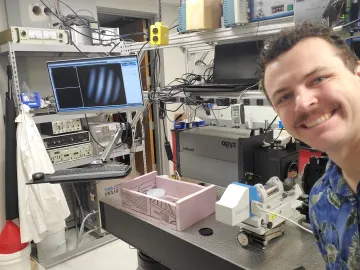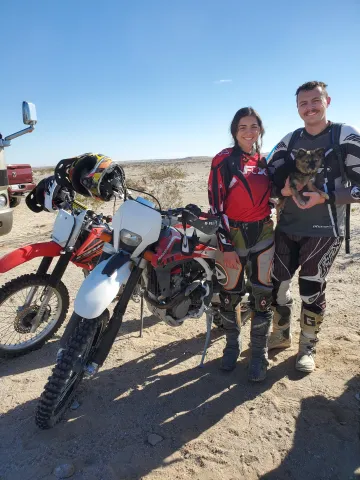Another Wavelength: Hayden Wisniewski

This week in Another Wavelength, we chat with 4th year Ph.D. student Hayden Wisniewski. Hayden is advised by Assistant Professor Brandon Chalifoux.
Where are you from?
I’m from “America’s Finest City,” San Diego, CA and lived in Spokane, WA during my undergrad.
What brought you to study optics?
One of my mentors in high school was a cofounder of a mid-infrared laser company in San Diego, and I had the opportunity to do an internship at the company during college. The company was using their lasers to jam incoming missiles and for early cancer detection. Needless to say, I was able to see some of the cool applications of optics. Then one of my mentors at Whitworth University (my alma mater) earned his PhD at University of Rochester in optics and encouraged me to explore the field.
Who is your hero in science?
My many mentors over the years are my heroes in science. Dr. Tim Day (co-founder of the mid‑infrared laser company) led me and others in a high school science project that would run experiments on the ISS, which piqued my interest in science. Dr. Kamesh Sankaran and Dr. John Larkin guided me during my undergrad and always encouraged me to find my own path forward. All of their excitement and passion for physics pushed me toward science. I feel extremely blessed to have been encouraged and guided by so many amazing people to get to the point that I am at now.
Describe your research in 20 words or fewer.
I am developing an absolute surface metrology technique for X-ray telescope mirrors.
Describe your research in 200 words or fewer.

X-ray telescope mirrors are inherently difficult to characterize due to being off-axis hyperboloids and paraboloids, which are approximately cylinders. For future X-ray telescope missions, these mirrors need to be characterized down to 5 nm uncertainties, which is difficult with cylinders.
I’m developing an absolute method, which we are calling lateral shift mapping, to measure these cylinders using a Fizeau interferometer. In a Fizeau interferometer, light is reflected off of a reference surface (assumed perfect) and off of a test surface. How this light interferes will tell us the surface under test. At the 5 nm level, we can’t assume that
the reference is perfect, so we must separate the two surfaces to know the surface profile.
Our technique involves taking a measurement of the surface with the interferometer, shifting it by the distance equal to a pixel of the interferometer, and then taking another measurement. Contributions to the interferogram due to the reference surface will remain stationary, whereas contributions due to the surface under test move. Using this knowledge we can separate the reference from the surface under test, which will allow us to know the surface under test with low uncertainty.
Name three neat facts about you.
- I’ve been riding off-road motorcycles since I was 4 years old. I have never had a Thanksgiving at home because I have been in the Ocotillo Wells riding area east of San Diego with my motorcycle riding group every year since I was born. That group is like my second family.
- I earned my private pilot’s license during my junior year at Whitworth University. I have even flown out of Tucson International.
- I love being outdoors in Tucson whether that be mountain biking, rock climbing, motorcycle riding, 4x4ing or golfing.

